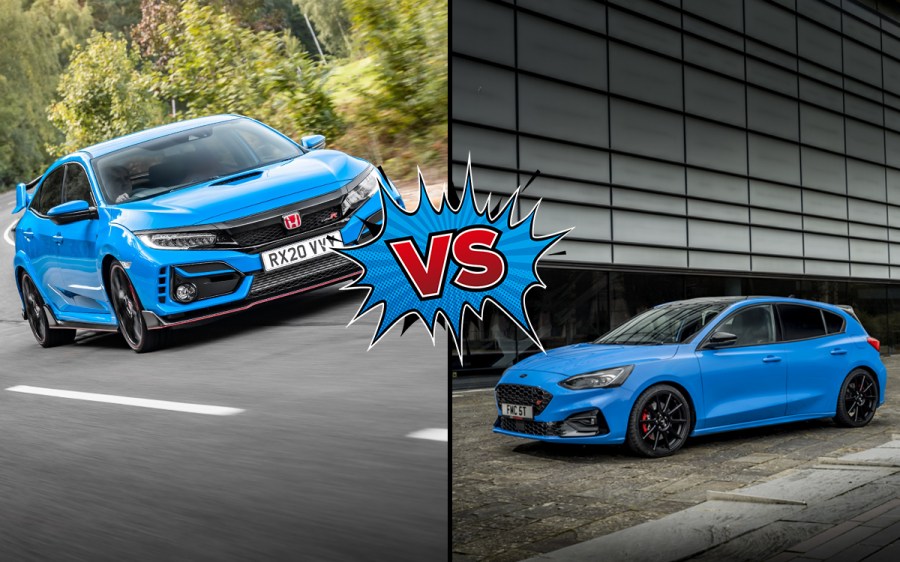The FK8 Honda Civic Type R and the Ford Focus ST Mk4 are two of the finest hot hatches of the modern era. But how do they stack up against each other?
Well, the FK8 has already become a bit of a modern classic; it helped the car’s reputation immeasurably that supply was so strangled over the final couple of years of its life, as the ensuing demand elevated it to cult status. Furthermore, with so many ‘car of the year’ awards gifted it by so many motoring outlets, all the rumors are true – it really is a transcendent car to drive. A proper full-fat hyperhatch, serving up eye-watering performance and superlative handling characteristics while also being eminently comfortable and well-equipped. It’s a polymath, and an incredible one.
The significance of the Ford Focus ST Mk4 stretches way beyond its strong specification or impressive capabilities. It’s about marking the closing chapter of something that’s close to all of our hearts, and doing so with style and flair. When people talk about Ford hot hatches, it’s natural to conjure up images of the Escort RS Turbo, the Fiesta XR2, the Focus RS… and has the Mk4 Focus ST earned the right to be considered among such a list of legends? Well, pathos alone dictates that it must; the swansong nature of this car means it’ll always be fondly remembered. Fortunately, it just so happens that it’s also an extraordinarily good hot hatch.
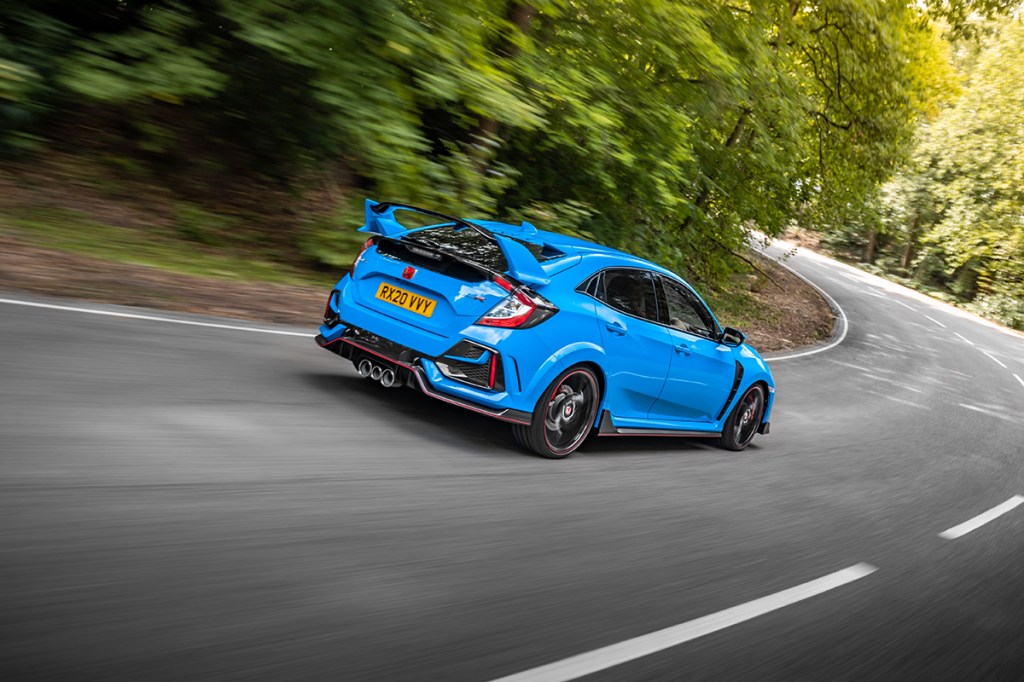
About the Honda Civic Type R FK8
On sale from 2017-2021, the FK8-generation Civic Type R was all about the numbers. Before it even hit the showrooms, Honda was boasting of its benchmark-setting Nordschleife time – a frankly unbelievable 7:43.8. For a smidge over thirty-grand, buyers were furnished with a tasty platter of figures – 316bhp, 169mph, 0-62mph in 5.7s, 1,380kg. And yes, we can assure you that the bonkers 169mph top speed is genuine… we tried it out on the autobahn, and it sits quite happily at that speed! You can really hear the aero working too, there’s a terrific sucking noise from the rear wing when you get past about 140mph.
The transition from FK2 to FK8 saw the existing engine and gearbox being carried over to the new model, with torque remaining the same and horsepower increased by 10bhp – but the chassis was entirely reimagined to create something a lot more cosseting and friendly than the often harsh-riding FK2 Type R. Standard trim was impressive too, with carbon fiber sideskirts and rear diffuser, and a distinctive triple-exit exhaust. (Fun fact: the smaller central pipe isn’t a full-time exhaust outlet or a wastegate – it’s there as a clever sort of resonator to dampen the sound at speed so the system doesn’t sound boomy on the motorway.)
FK8 Civic Type R buying tips
The quality of the gearshift is one of the best indicators of whether or not an FK8 has been looked after – it’ll be very obvious if it’s been abused as the shift from 1st to 2nd will be crunchy.
The two-piece discs on facelift models require careful inspection; it’s not unusual for them to sound a bit squeaky, but if you can see hairline cracks emanating from the drilled holes then they’ve clearly taken repeated harsh use and will require imminent replacement… and they aren’t cheap.
For more info, make sure you visit our FK8 Civic Type R buying guide.
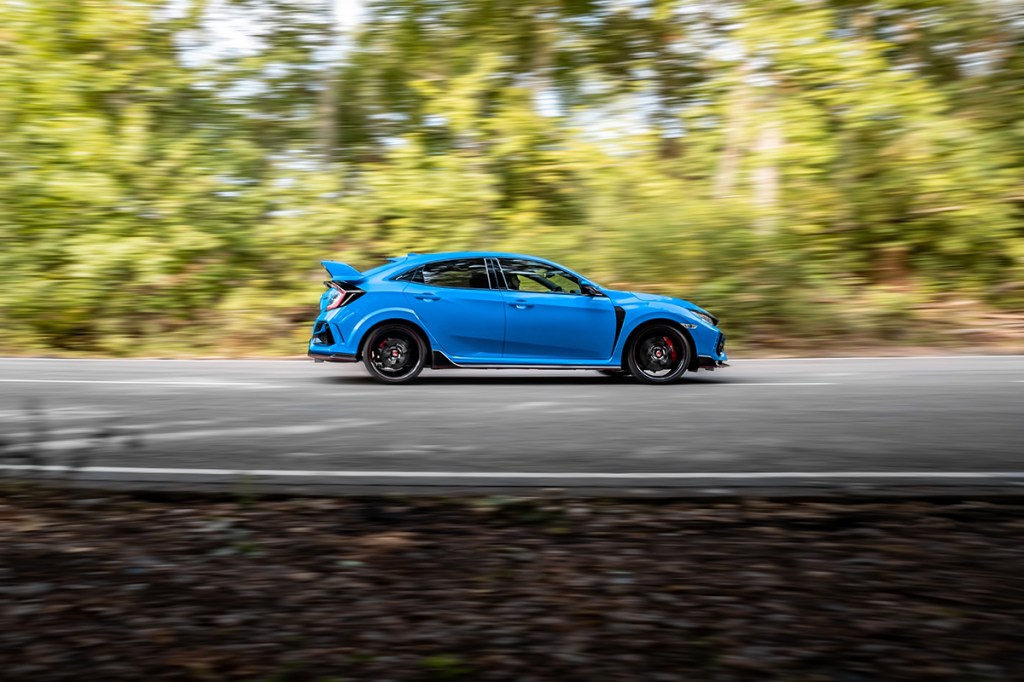
What is the Honda Civic Type R FK8 like to drive?
As you might imagine, the FK8 Civic is pretty astonishing. At first we weren’t expecting to find a massive change over the FK2, as on paper the FK8 seemed to offer little different beyond a smidge more power and a suspension redesign to replace the old torsion beam rear with a multi-link setup, but we’re very happy to eat our hats and say that, yes, the newer Type R genuinely does transcend the sub-brand to a whole other level.
The poise and delicacy are still there, but everything feels more scalpel-sharp, your steering inputs rewarded with an immediacy way beyond that of the older car (despite being a new electric system, surprisingly) while the revised suspension allows you to place the nose of the Civic directly into the apex of seemingly any corner regardless of speed, camber, surface or entry angle. As you follow through the corner, you sense that the agile little chassis is holding the car near-enough completely flat, it’s surreal.
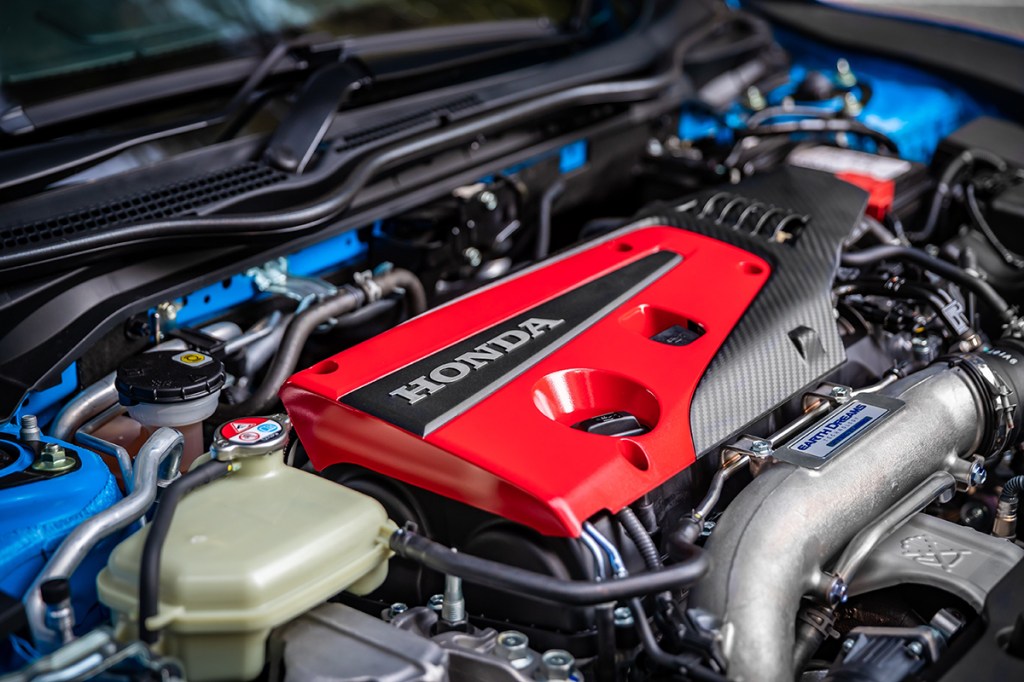
On track?
To the track. We’d already noted how the car’s on-road behavior was far improved over the FK2, which could be a bit bangy and crashy over bumps, and the revelation on track was that the +R button actually yields impressive tactility now. With the older car, it could be argued that the manic +R mode rather spoiled the experience, and we’d still like to see a more BMW-like interface whereby the parameters can be tailored (so that, for example, you could choose to keep the suspension in Sport while the throttle response switched to +R, or what-have-you), but nevertheless the FK8’s +R is far more logical. Loopy yet civilized, it allows you to wring the best from the car without shaking your spine out of the top of your head.
So you can use track mode on the road, and on the track the FK8’s just magical – those seats are typically superb, the gearbox has the perfect weight to its shift action, the brakes inspire so much confidence, and the way you’re able to thread the car between hot left-right interchanges without confusing the chassis is sublime. The swap from a dual- to a single-mass flywheel works beautifully in conjunction with the manner in which Honda have minimized turbo lag, meaning that the revs rise sharply and the car pulls hard from 2,500rpm right through to 7,000. In stock factory form, it’s both a fabulous road car and a tremendously capable track car. You can encourage it into oversteer if you taunt it with the brakes, but fundamentally this chassis is all about grip; about deploying those vast swells of horsepower in the most efficient manner possible.
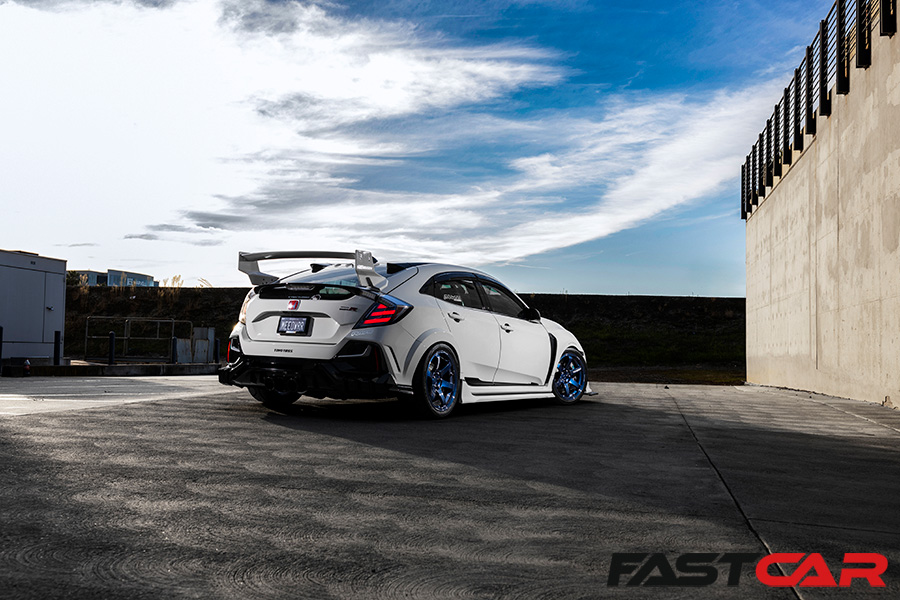
FK8 tuning potential
A standard FK8 Civic treated to a rolling-road mapping session can yield an additional 40-50hp and 40-50lb.ft. An uprated intercooler from HKS can give an extra 10bhp at peak, and Injen’s Evolution cold air intake system is a direct replacement item with dyno-proven gains up to 13bhp and 18lb.ft.
Exhaust options for the Type R are numerous, with the LEGAMAX system from HKS being among the most desirable. This swaps out the stock triple-pipe arrangement for two fat pipes with a burnt blue titanium finish, the 75mm main pipe diameter and straight design reducing exhaust pressure by 50%, which allows the turbo to run more efficiently at lower rpm.
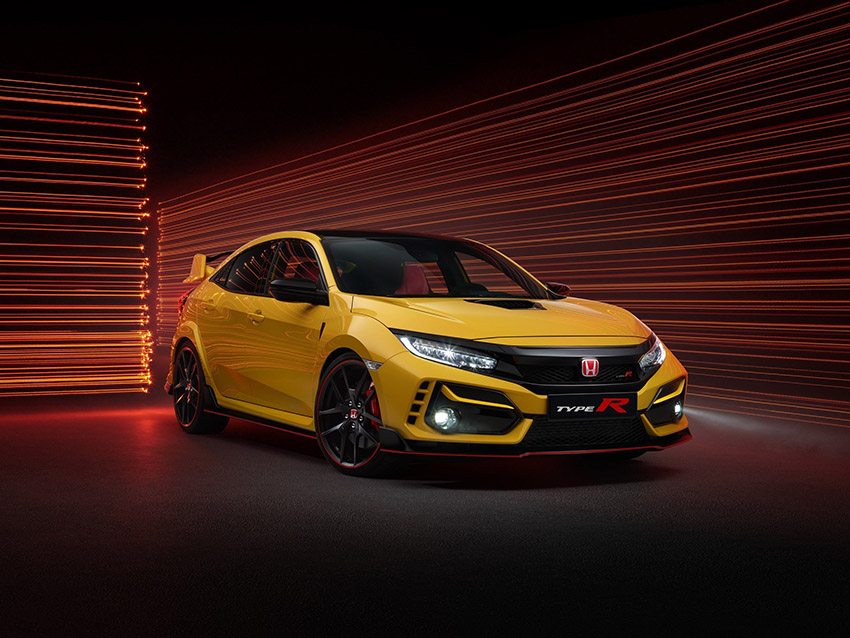
Any specs or special edition FK8s to be aware of?
The FK8 received a technical facelift in 2020, with a larger radiator, a 13% bigger front grille, and redesigned splitter. Two-piece brake discs were added, taking 15mm of travel out of the brake pedal for better feel. The adaptive damping was re-tuned to refine wheel control through aggressive cornering, and the ball-shaped gearknob was replaced with a more tactile teardrop design, like in a DC2 Integra or EP3.
There was also a new paint color in the line-up, Boost Blue, along with two new versions of the car: the Type R Sport Line was a little more subtle, a bit like Porsche’s ‘Touring’ option for the 911 GT3 – the Civic remained unchanged under the skin, but had a much smaller rear spoiler, downsized 19” wheels (instead of 20”), and the seats were trimmed in tasteful black instead of red. Going in the other direction, the Type R Limited Edition, of which only 20 came to the UK, was bright yellow and came with forged BBS wheels and Michelin Cup 2s as well as a whole load of weight loss – the stereo, air-con and sound deadening went in the bin.
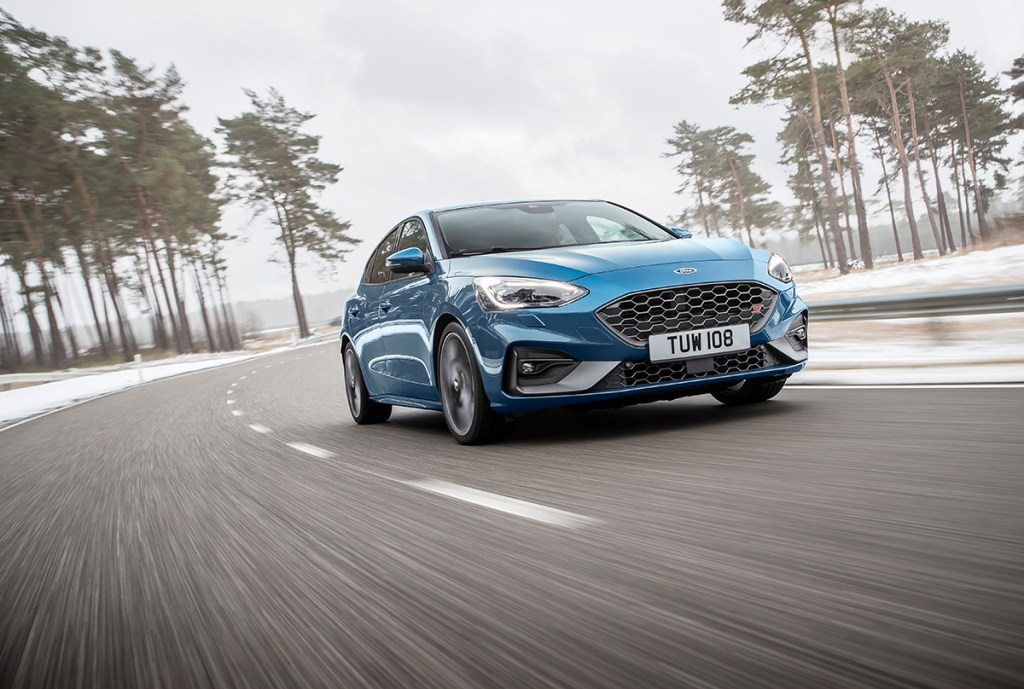
About the Ford Focus ST Mk4
Coming to market in early 2019, the Mk4 Focus ST came equipped with a 2.3-litre turbo four-pot serving up 276bhp, an iconic set of digits for anybody who grew up playing Gran Turismo in the nineties, with a decent chassis ensuring that it doesn’t all get spun away. We’re talking 0-62mph in 5.7s (an identical figure to the Civic, you’ll note) and a top whack of 155mph; impressively, the ST also boasts mpg in the mid-thirties, although that’s only if you’re not driving it like your hair’s on fire. Call the economy a sweetener, a representative of possibilities – this car can be sensible if you want it to.
It also represents the very zenith of what a hot hatch is meant to be. If you want to trundle to the supermarket or give your elderly neighbor a lift to the bingo, it can do so in quiet comfort with a zen-like calm. The boot is large and commodious, the rear seats have plenty of leg- and headroom, and the car’s equipped with a decent audio system. But prod it with a stick and it gets properly angry – this is a car that isn’t just quick, it feels it too. A hairy-chested hot hatch of the old-school, remixed for the modern era.
What is the Ford Focus ST Mk4 like to drive?
Ford has always known its way around a hot hatch, and that’s as much in the dynamism of the latest ST as it is the aesthetics and the equipment. The seats are impressively supportive on twisty B-roads while also being comfortable on long motorway journeys, and there’s a sharpness and intensity to the way it handles; the ride is stiff, but never jarring, while the brakes are reassuringly strong.
The engine is highly impressive too – it has very little lag and a lot of low-down torque, so it gets on with the business of deploying all of that horsepower with an impressive keenness. Let’s not forget that it wasn’t all that long ago that 276bhp was considered to be a very large number indeed – this is the realm of the Mk4 Toyota Supra Twin-Turbo, the Honda NSX, the Mitsubishi 3000GT, and all those other nineties performance heroes. And with a modern Ford you can have all of that without the histrionics.
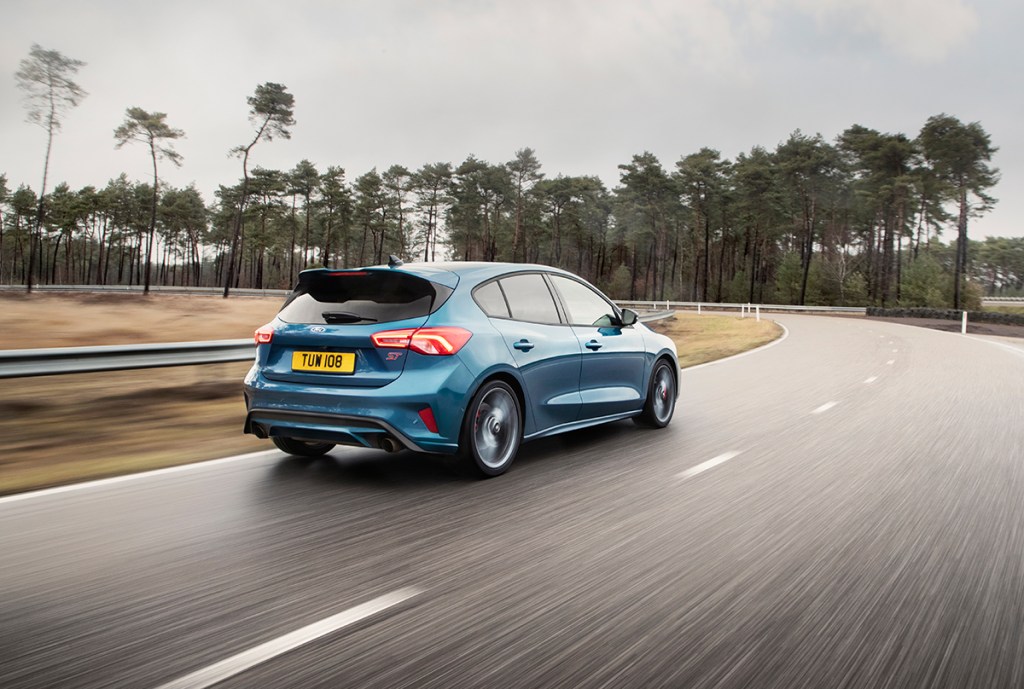
And on track?
You’ll be wanting the Track Pack. This is an option which essentially takes all the upgraded kit that was added to the limited-run Focus ST Edition of 2021, and applies it to a standard production ST (as long as it’s a manual hatchback). The quality Ford Performance coilovers fitted with the Track Pack absorb bumps and potholes instead of ricocheting off them, so the stiffness becomes a characteristic of faster driving rather than an impediment to it. Equally pleasing to note is that the faster you go, the better the ride feels, which is where the damping comes into its own on a flowing circuit.
The brakes are biblically good too – there was nothing really wrong with the standard ST stoppers, but the Track Pack Brembos are markedly more insistent, the pedal firmer, and that extra confidence in stopping power builds more confidence in the car as a whole. Give the Focus an instruction and it reacts, scalpel-sharp and instinctive. And that’s where we reach the real crux of the matter: this car feels like a classic analogue hot hatch. Sure, it’s got the big dash screens and the clever diff and whatnot, but it doesn’t feel sanitized and over-assisted like you might find in an Audi RS or a hot Golf. When you make good progress down a fun road, the Focus makes you feel like it was all your own work. It flatters you, it doesn’t feel like you’ve cheated.
Check out our full review of the Ford Focus ST Mk4 Edition.

Ford Focus ST Mk4 buying tips
The Focus is such a recent model that there’s not a huge amount to keep an eye out for beyond the usual risk of abuse that’s inherent to any hot hatch. The quality of some of the cabin materials isn’t class-leading so don’t be surprised to hear rattles from the dash and doorcards. Hard-driven cars will have stone-chipped noses, and check that all the panels are correctly aligned as this could indicate crash damage.
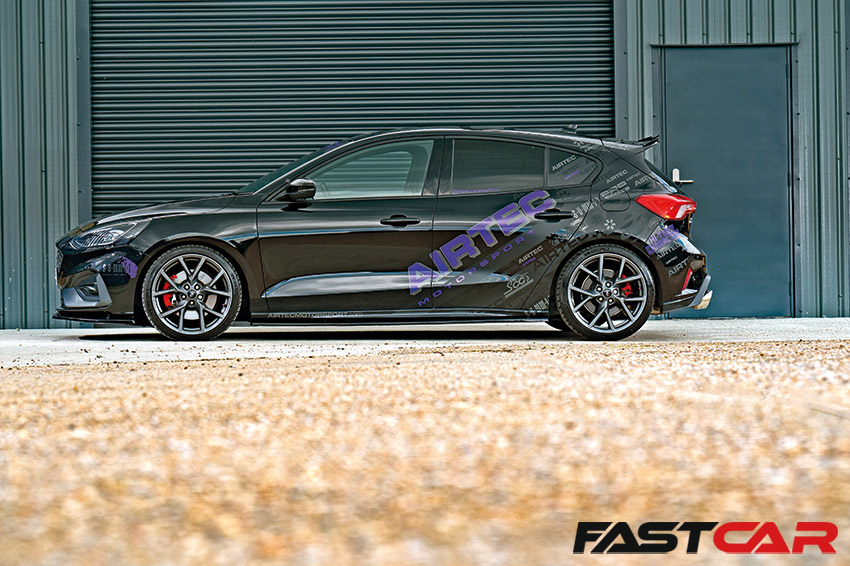
Ford Focus ST Mk4 tuning potential
The Focus is well supported by the aftermarket, and it doesn’t take a huge suite of mods to completely transform its character. A Mountune remap is your starting point, to make the best of some well-chosen upgrades: a Revo induction kit, Airtec intercooler with bigger boost pipes, Velossa Tech air scoop and Direnza 3” exhaust system will take you beyond 350bhp. Adding Eibach springs and Swave & Summit braces enhance the chassis – and there are a lot of aesthetic options too, from the likes of Maxton Design and Triple R Composites.
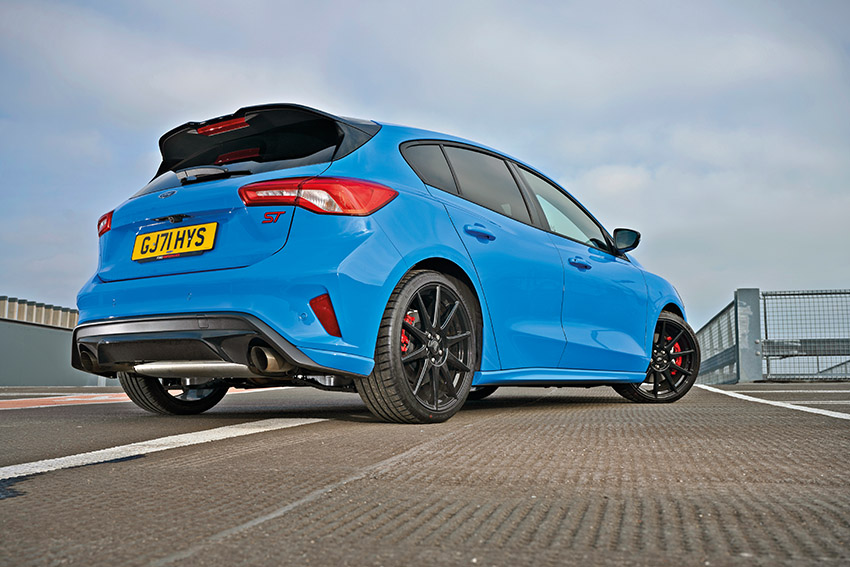
Any specs or special editions Focus ST Mk4s to be aware of?
The Performance Pack option was popular for the Focus, adding launch control and a Track mode. The ST Edition of 2021 was sold in small numbers (300 UK, 200 Europe) and came with KW coilovers, an eLSD and flow-formed alloy wheels. This, in turn, informed the Track Pack that’s now available as an option on any manual hatchback ST: the Track Pack bundle is a £3,000 package comprising two-way adjustable coilovers, four-pot Brembos at the front with larger 363mm discs, 19” flow-formed alloys and Pirelli P Zero Corsas.
How much are they?
As the FK8-generation was the first Civic Type R to be officially sold in North America, used car prices demand a slight premium over elsewhere in the world. The starting point tends to be around $28,000 for your higher-mileage cars. However, don’t be surprised by listings higher than $40,000…
Early FK8s start at £23,000 in the UK, rising to £32,000 for newer examples with low-mileage. Excellent cars are approaching £40,000. At time of writing, there’s a delivery-mileage Limited Edition on the market for £64,990, but that’s an extreme example.
Early Mk4 Focus STs start from £19,000, rising to £25,000 for low-mileage pre-facelift cars. The Edition will be c£30,000, with fresh examples of the facelifted ST starting from £31,000. The RRP of a brand-new Focus ST Track Pack is £39,950.

